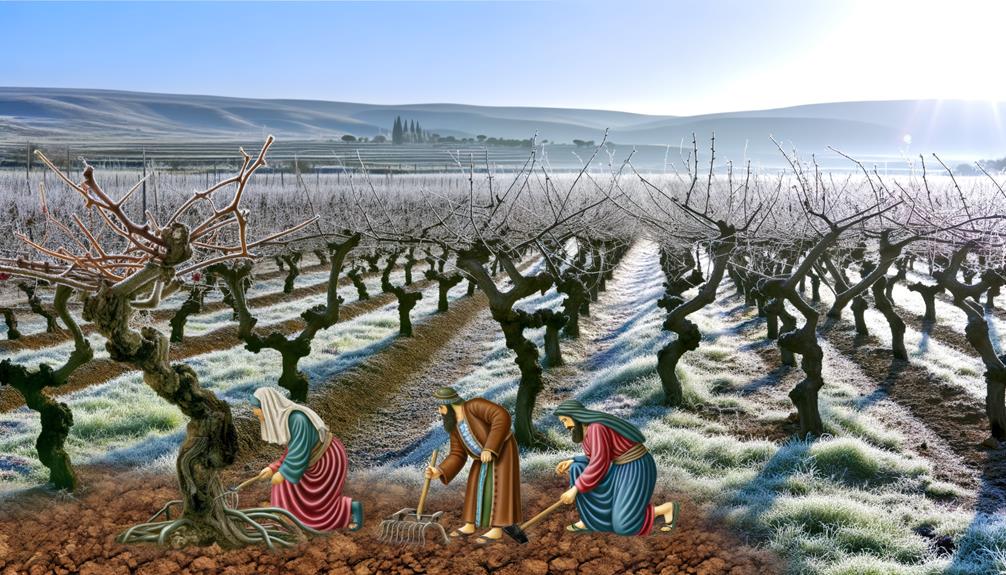February Meaning In The Bible: Symbolism and Significance
February does not appear in the Hebrew calendar, which follows a lunisolar system, but corresponds to the months of Shevat and Adar. Biblically, this period symbolizes spiritual introspection and renewal as nature shifts from winter to spring.
Key events, such as the completion of the Tabernacle and Purim, an important Jewish festival commemorating Esther’s deliverance of her people, fall around this time. Agriculturally, it marked the midpoint between winter dormancy and spring renewal, emphasizing preparation and faith.
To gain deeper insights into how these themes intertwine with scripture and historical events, there is more to reflect upon.

February Meaning in the Bible: Spiritual Significance and Symbolic Insights
| Aspect | Biblical Insight |
|---|---|
| Calendar Context | Not mentioned by name in the Bible; aligns with late winter in the Hebrew calendar |
| Hebrew Month Equivalent | Shevat and sometimes Adar, depending on the year |
| Seasonal Symbolism | Renewal, preparation, and hope before spring |
| Spiritual Theme | Growth through adversity and waiting on God’s timing |
| Key Scripture | Zechariah 1:7 – A vision given in the month of Shevat |
| Symbolic Reflection | A time of inner preparation, pruning, and spiritual expectancy |
Hebrew Calendar and February

The month of February does not exist in the Hebrew calendar, which follows a lunisolar system and uses different names for its months.
The Hebrew calendar, primarily used for religious observances in Judaism, comprises 12 or 13 months, depending on the alignment of lunar and solar cycles.
Unlike the Gregorian calendar, the Hebrew calendar starts its year with the month of Nisan in spring.
Months such as Shevat and Adar replace what would be January and February.
Adar, in particular, is unique because it can be doubled in leap years, forming Adar I and Adar II, to align the lunar months with the solar year.
This structure guarantees the calendar remains seasonally consistent, a critical aspect for agricultural and religious events.
Seasonal Symbolism

In the context of Biblical interpretations, February embodies profound seasonal symbolism, encapsulating winter’s spiritual significance.
This period is often viewed as a time for renewal and reflection, as the natural world enters a dormant phase, suggesting a pause for introspection and spiritual growth.
Analyzing these elements reveals how February’s themes of stillness and preparation resonate deeply within scriptural teachings.
Winter’s Spiritual Significance
Winter’s spiritual significance in the Bible often symbolizes a period of reflection, purification, and preparation for renewal, drawing parallels to the themes of endurance and hope that are prevalent throughout the scriptures.
This season’s harshness serves as a metaphor for trials and tribulations, urging believers to rely on faith and divine perseverance.
Winter’s dormancy invites a deeper connection with God, encouraging introspection and spiritual growth.
The Bible uses winter to teach essential lessons:
- Purification: Trials during winter refine one’s faith (Isaiah 1:18).
- Endurance: Enduring hardship strengthens our spiritual resolve (James 1:12).
- Hope: Winter’s end brings the promise of new beginnings (Psalm 126:5).
- Reflection: The quiet of winter fosters meditation and prayer (Psalm 46:10).
Renewal and Reflection
As seasons change from winter to spring, the Bible often uses this shift to symbolize themes of renewal and reflection that are central to spiritual growth.
February, positioned at this pivotal juncture, serves as a time for believers to introspect on their spiritual journey.
Scriptural passages like Isaiah 43:18-19, which speaks of God doing a ‘new thing,’ underscore the importance of leaving past transgressions behind and embracing divine transformation.
The dormant phase of winter mirrors the soul’s period of introspection, while the burgeoning life of spring represents the hopeful emergence of renewed faith.
This cyclical pattern encourages believers to reflect on their past, seek repentance, and prepare for spiritual rejuvenation, aligning their lives more closely with God’s purpose.
Nature’s Dormant Phase
How does the Bible leverage the dormant phase of nature to illustrate profound spiritual truths? The dormant phase, often represented by February, symbolizes a period of rest and preparation. This phase is essential for spiritual growth and reflection. Biblically, this time can be seen as an invitation to deepen one’s faith and understanding of divine timing.
Rest and Renewal: Just as the earth rests, believers are encouraged to find spiritual rest in God (Hebrews 4:9-10).
Reflection: This period allows for introspection and spiritual assessment, akin to Psalm 46:10’s call to ‘be still.’
Faith in Growth: Trusting unseen growth parallels the assurance of God’s unseen work (Mark 4:27).
Preparation for Renewal: Similar to nature’s cycle, spiritual dormancy prepares for future growth and renewal (Ecclesiastes 3:1).
Biblical Events in February

In examining Biblical events associated with February, it is essential to identify notable occurrences and scriptural references that align with this period.
Although the Bible follows a different calendar system, correlating notable events to our modern February reveals significant insights.
This exploration will highlight key moments and passages that provide a deeper understanding of the month’s biblical relevance.
Notable February Biblical Events
Despite the extensive chronologies and detailed events recorded in the Bible, there is a notable absence of specific references to the month of February within the scriptural narratives. The ancient Hebrew calendar, used in biblical times, does not correspond directly to the Gregorian calendar, which includes February. Consequently, identifying exact biblical events occurring in February is challenging.
However, several significant events align with the general timeframe of late winter or early spring in the Hebrew calendar:
- The completion of the Tabernacle (Exodus 40:2) – likely completed in the first month of the Hebrew calendar.
- Esther’s fast and deliverance of Jews (Esther 9) – celebrated during Purim, occurring in the spring.
- Completion of the wall of Jerusalem (Nehemiah 6) – completed in fifty-two days, possibly in early spring.
- Jesus’ early ministry (John 2) – including the wedding at Cana, likely occurring in late winter.
Key February Scriptural References
Although the Hebrew calendar does not directly correspond to the Gregorian calendar’s February, certain biblical events can be contextualized within this period through a careful examination of scriptural timelines and historical context.
For instance, the construction of the Tabernacle, which commenced in the month of Adar (late February to March), marks a significant episode.
Additionally, in the book of Esther, the preparations leading to the festival of Purim—celebrated in Adar—include pivotal events that align with February.
Festival of Purim

Celebrated annually in February or March, the Festival of Purim commemorates the deliverance of the Jewish people from a plot to annihilate them in ancient Persia, as recounted in the Book of Esther. This jubilant festival is marked by various customs and traditions that reflect its historical and religious significance.
Key elements include:
- Reading the Megillah: The Book of Esther is read aloud, emphasizing the miraculous events.
- Charitable Acts: Giving to the needy, known as ‘matanot la’evyonim,’ highlights community solidarity.
- Festive Meals: Families and friends gather for celebratory feasts, termed ‘seudat Purim.’
- Costume Wearing: Participants don costumes, symbolizing the hidden nature of the miracle.
These practices underscore Purim’s themes of survival, unity, and divine intervention.
Agricultural Cycles

While the Festival of Purim embodies themes of deliverance and celebration, February also plays a pivotal role in the Bible as it marks the midpoint of the agricultural cycle in ancient Israel, a period critical for the preparation and planting of crops.
This month signifies the shift from winter to spring, necessitating the tilling of soil and sowing of seeds.
Farmers in biblical times would meticulously plan their activities to guarantee a bountiful harvest.
The prophetic texts often draw parallels between physical planting and spiritual sowing, illuminating the interconnectedness of agriculture and faith.
Consequently, February’s agricultural significance underscores a broader theological narrative, emphasizing diligence, foresight, and divine provision within the agrarian society of ancient Israel.
Significance of the Number Two

In biblical numerology, the number two often symbolizes duality, partnership, and the concept of witness, reflecting a deeper theological and spiritual significance throughout the scriptures. This number appears repeatedly, underscoring essential biblical themes and doctrines.
For example:
- Creation: God created male and female, establishing the fundamental partnership in human relationships (Genesis 1:27).
- Testimony: The Old Scripture law required the testimony of two witnesses to confirm a matter (Deuteronomy 19:15).
- Covenants: The New Covenant follows the Old Covenant, illustrating the duality in God’s plan for humanity.
- Jesus’ Teachings: Jesus sent his disciples out in pairs to preach and heal, emphasizing collaboration and mutual support (Mark 6:7).
These instances highlight the multifaceted significance of the number two in biblical context.
Winter in Biblical Times

During biblical times, winter was a significant season that had profound implications on daily life, agricultural practices, and religious observances.
The colder months necessitated the storage of food and resources, as farming activities were limited. Shepherds tended to their flocks with heightened vigilance, ensuring their survival through harsher conditions.
Scriptural references, such as in Proverbs 20:4, highlight the importance of preparation, cautioning against the neglect of winter’s demands.
Additionally, winter influenced travel and communication, often leading to a slower pace of communal activities.
Religious practices adapted to the season, reflecting a period of reflection and reliance on divine provision.
Understanding winter’s role provides insight into the lived experiences and adaptive strategies of biblical communities.
Spiritual Reflections

Often intertwined with the rhythm of the seasons, spiritual reflections in the biblical context reveal a profound connection between temporal experiences and divine wisdom.
February, a month of change, symbolizes a period of introspection and renewal. The Bible encourages believers to use this time for self-examination, repentance, and spiritual growth. This process is vital for aligning one’s life with God’s will.
Key spiritual reflections for February include:
- Renewal of Faith: Just as nature prepares for spring, believers are urged to renew their commitment to their faith.
- Repentance: Acknowledging and turning away from past wrongdoings.
- Hope: Embracing the promise of new beginnings and divine guidance.
- Community: Strengthening bonds within one’s faith community through shared worship and support.
These elements collectively enhance one’s spiritual journey.
Conclusion
In examining February’s biblical significance, one unearths a tapestry woven from Hebrew calendrical traditions, seasonal symbolism, and historical events.
The month intertwines with the Festival of Purim, agricultural cycles, and the biblically symbolic number two.
Winter’s chill in biblical times mirrors spiritual introspection and renewal.
Consequently, February serves not merely as a temporal marker but as a profound period for reflection, embodying the intricate dance between the divine and the earthly, the temporal and the eternal.






